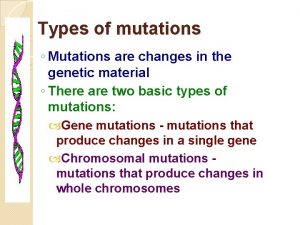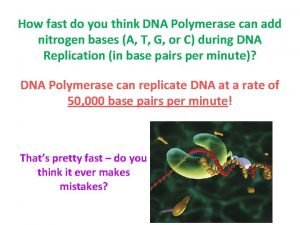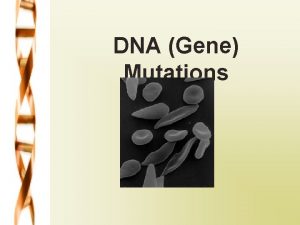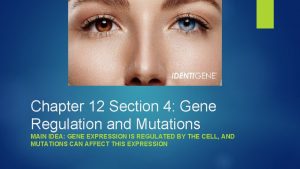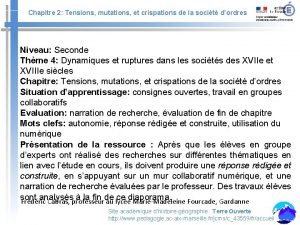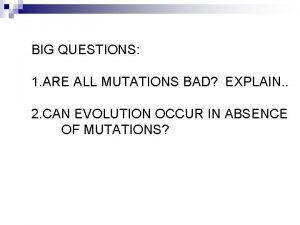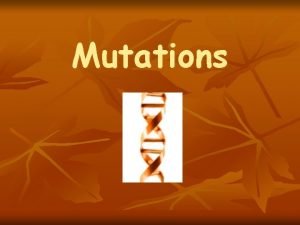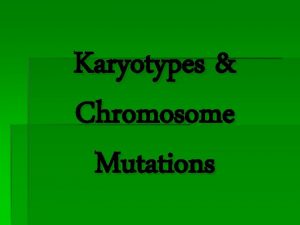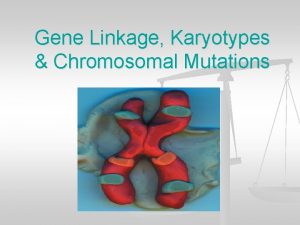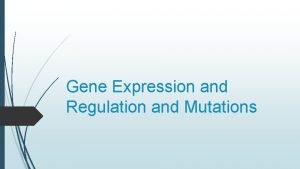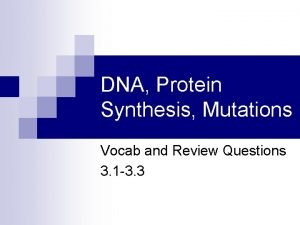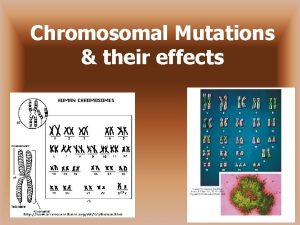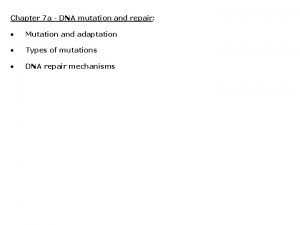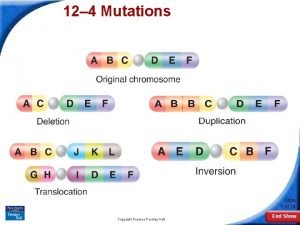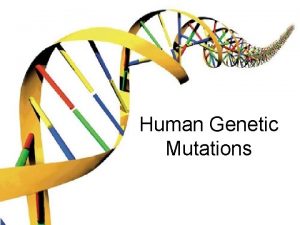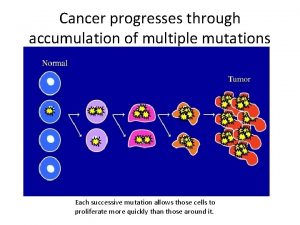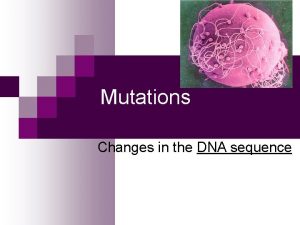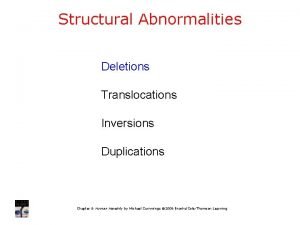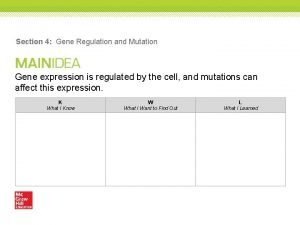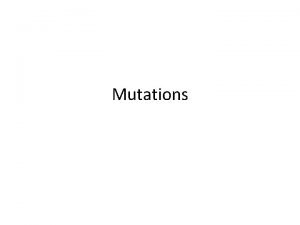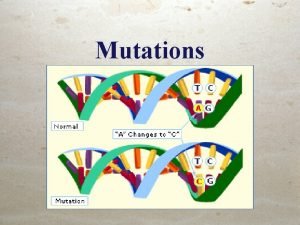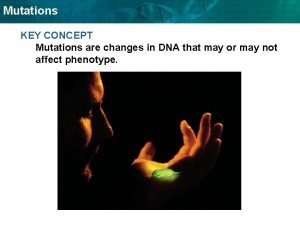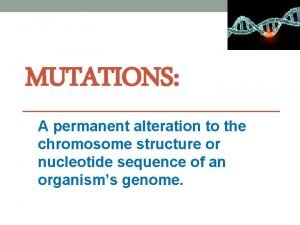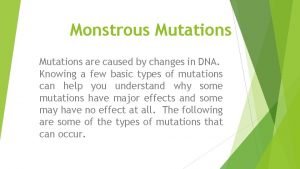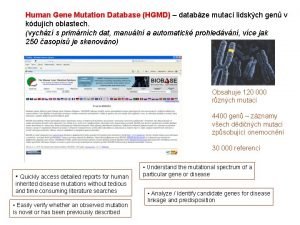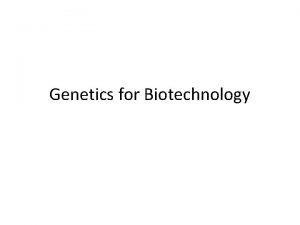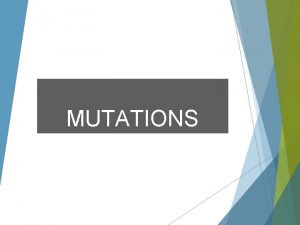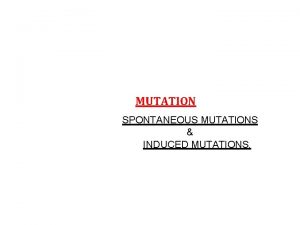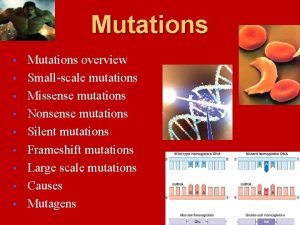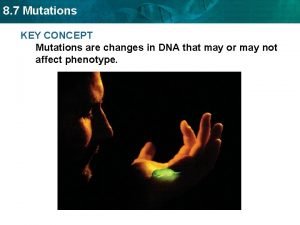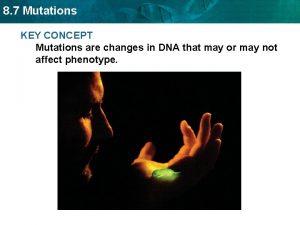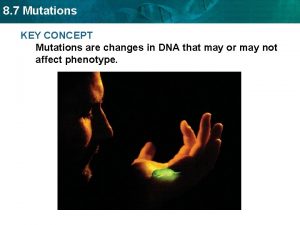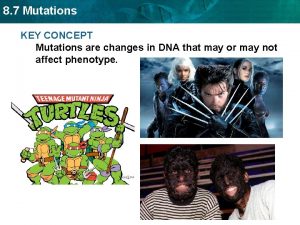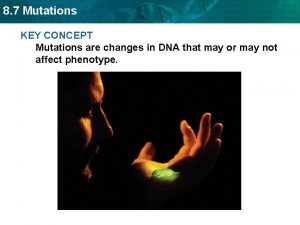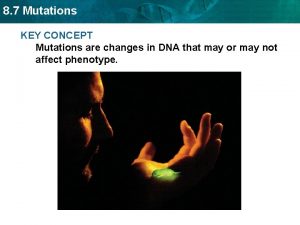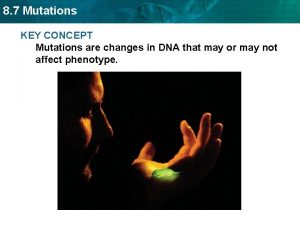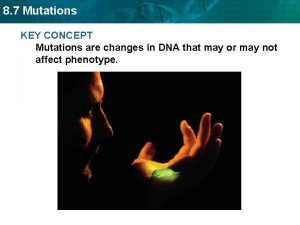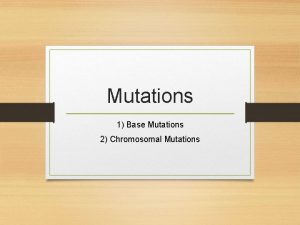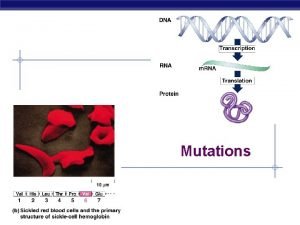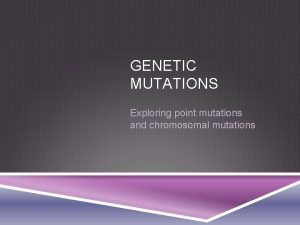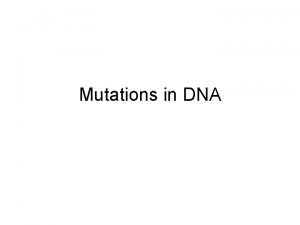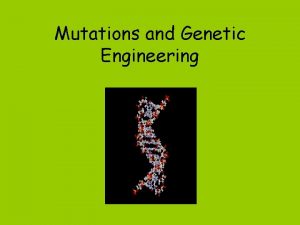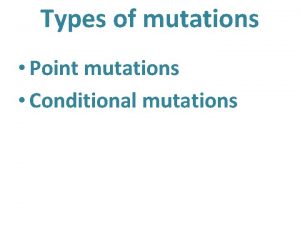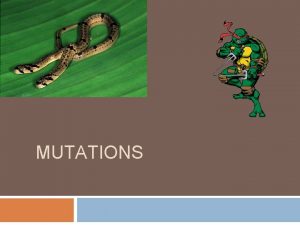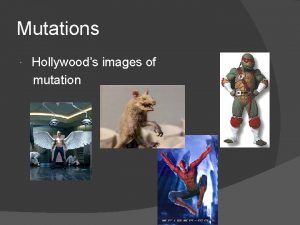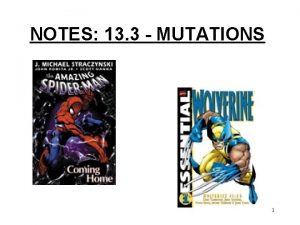MUTATIONS WHAT ARE MUTATIONS KEY CONCEPT Mutations are









































- Slides: 41

MUTATIONS

WHAT ARE MUTATIONS? KEY CONCEPT: Mutations are changes in genetic material. VOCABULARY: Mutation, point mutation, frameshift mutation, polyploidy

Mutations – extension from gene expression. Changes in genotype can result in changes in phenotype. The function and amount of gene products determine the phenotype of organisms. The normal function of the genes and gene products collectively comprises the normal function of organisms. Disruptions in genes and gene products cause new phenotypes.

Mutations – extension from gene expression. Alterations in a DNA sequence can lead to changes in the type or amount of the protein produced and the consequent phenotype. DNA mutations can be positive, negative, or neutral based on the effect or the lack of effect they have on the resulting nucleic acid or protein and the phenotypes that are conferred by the protein. Examples: Mutations in the CFTR gene disrupt ion transport and result in cystic fibrosis. Mutations in the MC 1 R gene give adaptive melanism in pocket mice.


Mutations – extension from gene expression. The processing of genetic information is imperfect and is a source of genetic variation. Errors in DNA replication or DNA repair mechanisms, and external factors, including radiation and reactive chemicals, can cause random mutations in the DNA. Whether a mutation is detrimental, beneficial, or neutral depends on the environmental context. Mutations are the primary source of genetic variation.

Mutations – extension mitosis & meiosis Errors in mitosis or meiosis can result in changes in phenotype. Changes In Chromosome Number Often Result in new phenotypes, including sterility caused by triploidy, and increased vigor of other polyploids. human disorders with developmental limitations, including Down syndrome/ Trisomy 21 and Turner syndrome /X-

Mutations – effects on evolution Changes in genotype may affect phenotypes that are subject to natural selection. Genetic changes that enhance survival and reproduction can be selected for by environmental conditions. The horizontal acquisitions of genetic information primarily in prokaryotes via processes below, increases variation. Transformation (uptake of naked DNA) Transduction (viral transmission of genetic information), Conjugation (cell-to-cell transfer of DNA), Transposition (movement of DNA segments within and between DNA molecules)

Mutations – effects on evolution Related viruses can combine/recombine genetic information if they infect the same host cell. Reproduction processes that increase genetic variation are evolutionarily conserved and are shared by various organisms. Examples include: Antibiotic resistance mutations Pesticide resistance mutations Sickle cell disorder and heterozygote advantage

HOW DO MUTATIONS HAPPEN? There are two ways in which DNA can become mutated: 1. Mutations can be inherited. This means that if a parent has a mutation in his or her DNA, (in gamete or germ cells) then the mutation is passed on to his or her children. 2. Mutations can be acquired. This happens when environmental agents damage DNA, or when errors occur when a cell copies its DNA prior to cell division.

Effects of mutations on proteins Some proteins are more important to a cell's normal function than others. A cell might still be able to function properly if the mutated protein isn't that important.

KINDS OF MUTATIONS 1. MICROMUTATIONS: Gene mutations result from changes in a single gene.

KINDS OF MUTATIONS 2. MACROMUTATIONS: Chromosomal mutations involve changes in whole chromosomes.

1. MICROMUTATIONS OR GENE MUTATIONS Point Mutations Affect one nucleotide Occur at a single point in the gene sequence Three Types: Substitution 2. Insertion 3. Deletion 1. Result in frameshifts

Point Mutations Substitution A single nucleotide is changed in the nucleotide sequence. This may result in a change to a single amino acid in the protein. The change to a single amino acid may or may not alter the proteins function.

Point Mutations - Substitution Codon UGU UGC UGG UGA = Amino Acid Original Cysteine No Change Cysteine Single AA Tryptophan Bad STOP

GENE MUTATION: SUBSTITUTION DNA: TAC GCA m. RNA: AUG CGU TGG ATT ACC UUA Amino Acid: MET ARG THR LEU Substitution DNA: m. RNA: Amino Acid: TAC GTA AUG CGU MET HIS TGG ACC ATT UUA THR LEU

Substitution Mutations 3’AGTTCAG-TAC-TGA-ACA-CCA-TCA-ACT-GATCATC 5’ 5’AGUC-AUG-ACU-UGU-GGU-AGU-UGA-CUAGAAA 3’ Transition Met Thr Cys Gly Ser 3’AGTTCAG-TAC-TGA-ATA-CCA-TCA-ACT-GATCATC 5’ 5’AGUC-AUG-ACU-UAU-GGU-AGU-UGA-CUAGAAA 3’ Met Thr Tyr Gly Ser Pyrimidine to Pyrimidine 3’AGTTCAG-TAC-TGA-ACA-CCA-TCA-ACT-GATCATC 5’ 5’AGUC-AUG-ACU-UGU-GGU-AGU-UGA-CUAGAAA 3’ Transversion Met Thr Cys Gly Ser 3’AGTTCAG-TAC-TGA-AAA-CCA-TCA-ACT-GATCATC 5’ 5’AGUC-AUG-ACU-UUU-GGU-AGU-UGA-CUAGAAA 3’ Met Thr Phe Gly Ser Purine to Pyrimidine

Point Mutations Frameshift Mutations Result From Insertions & Deletions A nucleotide is added, or subtracted from the nucleotide sequence. This shifts the Codon grouping and drastically alters the amino acid sequence in the protein from that point on.

GENE MUTATION: INSERTION DNA: TAC GCA m. RNA: AUG CGU TGG ATT ACC UUA Amino Acid: MET ARG THR LEU Insertion DNA: m. RNA: Amino Acid: TAT CGC AUA GCG ILE ALA ATG UAC TRY GAA T CUU A LEU

GENE MUTATION: DELETION example THE FAT CAT ATE THE RAT Deletion of the first H THE F AT C TEF ATC AT A TE T ATA TET HE R HER AT AT The loss of a single DNA base can change the entire message that DNA sends to make a protein! DIFFERENT DNA MESSAGE = DIFFERENT PROTEIN

Frame Shift Mutations 3’AGTTCAG-TAC-TGA-ACA-CCA-TCA-ACT-GATCATC 5’ 5’AGUC-AUG-ACU-UGU-GGU-AGU-UGA-CUAGAAA 3’ Met Thr Cys Gly Ser 3’AGTTCAG-TAC-TGA-AAC-CAT-CAA-CTG-ATCATC 5’ 5’AGUC-AUG-ACU-UUG-GUA-GUU-GAC-UAG-AAA 3’ Met Thr Leu Val Val Frame shift mutations tend to have a dramatic effect on proteins as all codons down stream from the mutation are changed and thus code for different amino acids. As a result of the frame shift, the length of the polypeptide may also be changed as a stop codon will probably come at a different spot than the original stop codon.

2. MACROMUTATIONS: CHROMOSOMAL MUTATIONS Changes the number or structure of chromosomes As a result the locations of genes on chromosome or the number of copies of some genes may change.

2. MACROMUATIONS: CHROMOSOMAL MUTATIONS 1 Deletions - Loss of chromosome sections 2 Duplications - Duplication of chromosome sections 3 Inversions - Flipping of parts of chromosomes 4 Translocations - Movement of one part of a chromosome to another part

MACROMUTATION: DELETION X Deletion Loss of all or part of a chromosome

MACROMUTATION: DELETION Centromere A A B B C C Genes D D E G F H Original chromosome G H New Chromosome E F

MACROMUTATION DUPLICATION Duplication Segment of chromosome is repeated

MACROMUTATION: DUPLICATION Centromere A B C Original chromosome Genes D E F G H New Chromosome A B C D E F Duplication G H

MACROMUTATION: INVERSION Inversion Chromosome or part of a chromosome is placed in the reverse direction

MACROMUATION: INVERSION Centromere A B C Original chromosome Genes D E F G H New chromosome A B C D F E Inversion G H

MACROMUTATION: TRANSLOCATION Translocation Part of one chromosome breaks off and attaches to another chromosome

MACROMUTATION: TRANSLOCATION Centromere A B Original Chromosome Genes C D E F G H New chromosome A B E F C D G H

SIGNIFICANCE OF MUTATIONS Most mutations are NEUTRAL— they have little or no effect on genes or the function of proteins. We all have mutations within our DNA

HARMFUL MUTATIONS Mutations can cause a dramatic changes in the protein structure are often HARMFUL. THESE DEFECTIVE PROTEINS CAN DISRUPT NORMAL BIOLOGICAL ACTIVITIES. Harmful mutations are associated with many types of cancers.

BENEFICIAL MUTATIONS Mutations are also the source of GENETIC VARIATION in a species. Beneficial mutations may produce proteins with new or altered activities that can be useful to organisms in different or changing environments.

BENEFICIAL MUTATIONS POLYPLOIDY: organism has extra sets of chromosomes When a complete set of chromosomes fail to separate during meiosis, the gametes that result may produce TRIPLOID (3 N) or TETRAPLOID (4 N) organisms.

BENEFICIAL MUTATIONS Polyploid plants are often larger and stronger than diploid plants. Important crop plants have been produced in this way. Example: bananas, citrus fruits, seedless plants

INHERITED MUTATIONS DNA fails to copy accurately Most of the mutations that we think matter to evolution are "naturallyoccurring. " For example, when a cell divides, it makes a copy of its DNA — and sometimes the copy is not quite perfect. That small difference from the original DNA sequence is a mutation.

INHERITED MUTATIONS

EXTERNAL INFLUENCES CAUSE MUTATIONS Mutations can be caused by exposure to specific chemicals or radiation. These agents cause the DNA to break down.

EXTERNAL INFLUENCES CAUSE MUTATIONS This is not necessarily unnatural — even in the most isolated and pristine environments, DNA breaks down. Nevertheless, when the cell repairs the DNA, it might not do a perfect job of the repair. So the cell would end up with DNA slightly different than the original DNA and hence, a mutation.
 Antigentest åre
Antigentest åre Minerals concept map
Minerals concept map Key concept builder lesson 1 what are waves answer key
Key concept builder lesson 1 what are waves answer key The business model canvas
The business model canvas Business model canvas tripadvisor
Business model canvas tripadvisor Ideal self vs true self
Ideal self vs true self Perbedaan selling concept dan marketing concept
Perbedaan selling concept dan marketing concept Types of mutations
Types of mutations What are some neutral mutations
What are some neutral mutations Amoeba sisters mutations worksheet
Amoeba sisters mutations worksheet 5 causes of mutation
5 causes of mutation Chapter 14 lesson 4 mutations
Chapter 14 lesson 4 mutations Section 4 gene regulation and mutation
Section 4 gene regulation and mutation Tensions mutations et crispations de la société d'ordres
Tensions mutations et crispations de la société d'ordres Dna types of mutations
Dna types of mutations Helpful mutation
Helpful mutation Missense mutation in sickle cell anemia
Missense mutation in sickle cell anemia Slidetodoc.com
Slidetodoc.com Chromosomal mutation
Chromosomal mutation Examples of chromosomal mutations
Examples of chromosomal mutations Protein synthesis and mutations
Protein synthesis and mutations Protein synthesis and mutations
Protein synthesis and mutations Chromosomal mutation
Chromosomal mutation Mutation and adaptation
Mutation and adaptation 12-4 mutations
12-4 mutations Cancer mutations
Cancer mutations Substitution mutation
Substitution mutation Cancer mutations
Cancer mutations Cancer mutations
Cancer mutations Dna types of mutations
Dna types of mutations Forward mutation
Forward mutation Mutations translocation
Mutations translocation Section 4 gene regulation and mutation
Section 4 gene regulation and mutation Chromosomal mutation
Chromosomal mutation Mutation is any mistake or change in the
Mutation is any mistake or change in the Gene mutations
Gene mutations Vertus hardiman
Vertus hardiman Monstrous mutations
Monstrous mutations Types of mutations
Types of mutations Databze
Databze Somatic mutations
Somatic mutations Central dogma
Central dogma







